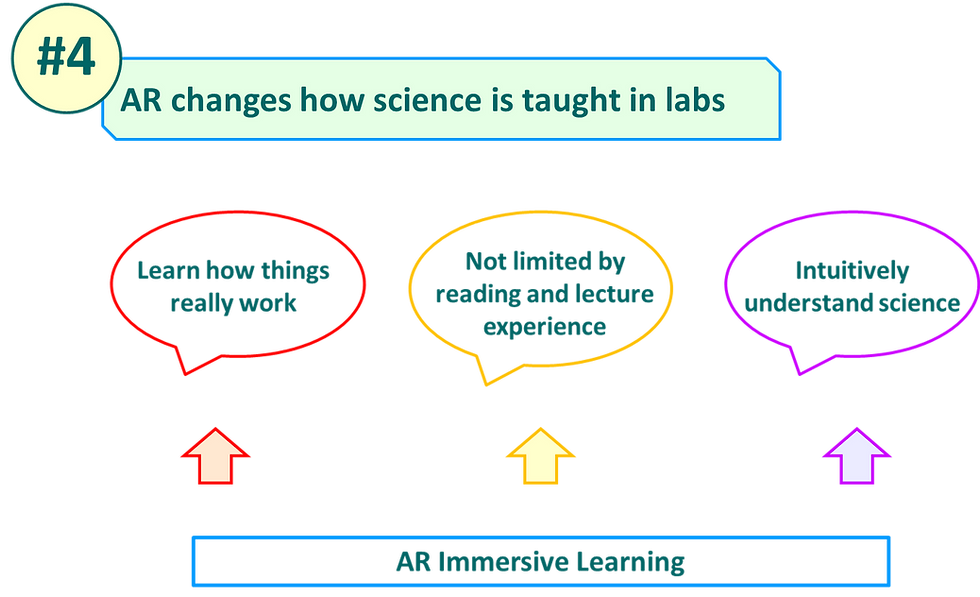
Augmented Reality is an important emerging technology that is starting to break into many major industries and sectors. Leading technology companies have been heavily investing in development of both hardware and software platforms that enable and unleash the great potential of AR.
The Hardware race to develop the most widely adopted head mounted display (HMD) is led by Microsoft Hololens, Magic Leap and Meta. Software, especially mobile based platforms, is widely available using software development kits (SDKs) like Unity, Apple’s ARKit and Google’s ARCore.
There have been promising early adoption and traction in industries such as logistics, engineering, manufacturing, product design, and consumer home improvement and furnishing.
The global laboratory industry has a market size of hundreds of billions of dollars annually. Laboratories are present in many important and fundamental economic sectors, including government research, education, health care, manufacturing, and technologies. Today, laboratories are achieving their scientific education and research goals in new ways by applying fast growing modern technologies.
One of those opportunities is the movement of laboratory digitization.
The concept of digital laboratories was a very new even a few years ago. For most people who work in laboratories, their understanding of digital labs stayed at the basic level of digital database (e.g. LIMS systems) and internet connectivity. But today, by leveraging new technologies including artificial intelligence (AI), cloud computing, internet of things (IoT), and immersive technologies like Augmented Reality (AR) or Virtual Reality (VR), scientists and technologists are starting to experience a modernized way of working in laboratories. Many of the applications using these types of new technologies are still in the testing phase and will take some time before wide adoption. However, immersive technologies, including AR and VR, are examples of the front runners that are generating tangible results today.
Let’s look at some of the important ways that AR technology will fundamentally change how scientists work in labs.

1. AR changes scientists’ purchasing decisions
To perform their jobs in labs effectively, scientists and technicians rely on many laboratory tools and instruments.
- AR can help scientists visualize how the lab would look using augmented new instrument, equipment and set up in existing lab environment, by superimposing the 3D digital twins of the objects.
- AR can also help scientists understand how these tools and equipment help their research activities by enabling them to interact with AR models that simulate how things work.
- Manufacturers and suppliers of lab equipment and instrument can leverage AR technology to better demonstrate how their products functionalities and features.
- For example, instrument manufactures demonstrate superior functionalities and physical footprints of their products to perspective customers during face-to-face sales visits and onsite demos.

2. AR changes scientists’ workflow in their labs
How scientists use traditional manuals, instructions, standard operating procedures (SOPs), and guiding notes today is not only inefficient and difficult to follow, but also mind-numbingly boring.
- By turning this information digitally overlaid onto the physical world where instruction is needed in-situ and on-demand, workflows in lab are streamlined.
- Instructions and procedures are much more interactive and intuitive because they are delivered to users within context of the physical world.
- For example, when an analytical lab technician is going to perform an experiment on an instrument, the AR tool will help her to select the right consumables or parts, making sure samples go on the equipment with proper orientation, the right position and the right amount, guiding her through necessary steps to collect data, and prompting reminders of safety tips and clean-up steps.

3. AR changes data visualization for scientists
How scientists collect and record data might be limited to how the equipment and tools input and output work. However, with the help of AR technology, the visualization of the data now becomes much more intuitive and interesting.
- For example, the scientist scans across her lab space using the AR interface and sees the process of each experiment or data collection process as digital overlay in her view, either through AR head mounted device or model screen. Even more, she can interact with any particular set of data and visualize in the 3D interactive immersive way.
- Here are a few specific real life examples of this. Today, technologists are monitoring the real time data from a turbine engine that is augmented on particular parts of the engine where the data is coming from. Medical scientists are visualizing patient data from CT scans or MRI scans that are superimposed onto models of organs and body parts.


Comments